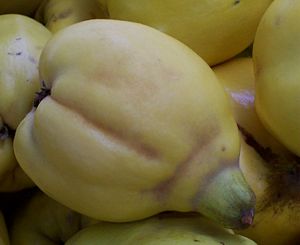Quince: Difference between revisions
Jump to navigation
Jump to search

imported>Petréa Mitchell (Written by me, various sources) |
imported>John Dvorak m (apple disambig) |
||
| Line 5: | Line 5: | ||
'''Quince''' is the name of a small tree of the genus ''[[Cydonia]]'', also grown as a shrub, and the fruit produced by that tree. Quinces are native to [[Iran]] and [[Turkey]]. | '''Quince''' is the name of a small tree of the genus ''[[Cydonia]]'', also grown as a shrub, and the fruit produced by that tree. Quinces are native to [[Iran]] and [[Turkey]]. | ||
Quinces are grown under similar conditions to [[apple]] and [[pear]] trees, and are susceptible to many of the same diseases and pests, such as [[fire blight]] and [[scale insects]]. | Quinces are grown under similar conditions to [[Apple (fruit)|apple]] and [[pear]] trees, and are susceptible to many of the same diseases and pests, such as [[fire blight]] and [[scale insects]]. | ||
Being naturally high in [[pectin]], the fruit is used mainly for [[jelly|jellies]] and [[preserves]], but may also be eaten baked or prepared like other fruits. | Being naturally high in [[pectin]], the fruit is used mainly for [[jelly|jellies]] and [[preserves]], but may also be eaten baked or prepared like other fruits. | ||
Revision as of 14:52, 3 May 2008
Quince is the name of a small tree of the genus Cydonia, also grown as a shrub, and the fruit produced by that tree. Quinces are native to Iran and Turkey.
Quinces are grown under similar conditions to apple and pear trees, and are susceptible to many of the same diseases and pests, such as fire blight and scale insects.
Being naturally high in pectin, the fruit is used mainly for jellies and preserves, but may also be eaten baked or prepared like other fruits.
